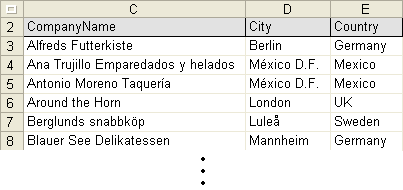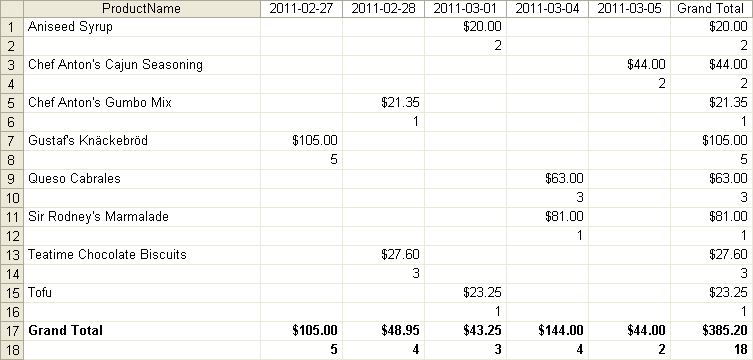Pivot tables enable you to quickly and easily obtain and visualize various statistical
information about data coming from flat source record tables. This includes (but is
not limited to) counting, summarizing, sorting or finding partial maximum/minimum values.
Pivot formulas have the following form:
pivotData(source, rows, columns, data, functions, options [, field1, filter1, field2, filter2, ...])
The above formula creates and returns a pivot table for the data in the 'source' range.
The 'rows', 'columns' and 'data' parameters represent arrays/ranges containing the respective pivot field indices. The indices are relative to the top-left corner of the 'source' range and the numbering starts from 1.
For example: {1, 5}, {4}, {1}
If some of the indices are incorrect, pivotData returns the #VALUE! error. In GS-Calc 9.0 the 'columns' array can contain only one element. The 'data' fields can be omitted, in which case the last specified row field
and the default pivot function will be used (for the last row field).
The 'functions' argument is an array of predefined functions constants/IDs associated with the specified data fields. The possible values are:
- PIVOT::Sum
- PIVOT::SumPositive
- PIVOT::SumNegative
- PIVOT::SumSquares
- PIVOT::Count
- PIVOT::CountPositive
- PIVOT::CountNegative
- PIVOT::CountZeroes
- PIVOT::Min
- PIVOT::Max
For example: {PIVOT::Sum}, {PIVOT::Sum, PIVOT::Count}
Note: You must specify either the PIVOT::ColumnGrandTotals or at least one column field.
Otherwise the function will return the #NUM! error code.
The 'options' parameter can be any sum of the following constants:
- PIVOT::ColumnGrandTotals - display column grand totals in the last column
- PIVOT::RowGrandTotals - include row grand totals in the last row
- PIVOT::SubTotals - include subtotals (for pivot tables with 2 or more row fields)
- PIVOT::ShowZeroes - show zeroes for empty data fields; without this option 'empty' subtotals will be displayed as the #N/A! error codes
- PIVOT::RepeatRowFields - if multiple row fields are specified, display all their values, even duplicated ones
- PIVOT::CaseSensitive - if filters are specified, use case sensitive comparison
- PIVOT::SortRowsDescending - present the output rows using the descending sort order
- PIVOT::SortColumnsDescending - present the output columns using the descending sort order
- PIVOT::NoSourceFieldNames - the source range contains no field names in the first row; use the 'Field n.' names instead
- "SEARCH::IgnorePunctuation (or 16384) - use the word sort order (ignoring certain punctuation marks) when sorting and filtering.
- "SEARCH::NeutralSortOrder (or 32768) - use neutral, language independent string comparison instead of the default language specific comparison when sorting and filtering.
- "SEARCH::Pattern (or 65536) - treat filters that don't start with (=,>,>=,<,<=) operator as simple (wildcard) patterns.
For example: {PIVOT::ColumnGrandTotals}, {PIVOT::ColumnGrandTotals + PIVOT::RowGrandTotals + PIVOT::SubTotals}
The optional [field, filter] pairs specify the 1-based field index and the condition. Only source data meeting all the specified
conditions will be included in the pivot table. Conditions can have the following form:
- A text string beginning with the =,>,>=,<,<= operators.
- A number or a search pattern: a text string containing special characters '?' (any character) or '*' (any string, including an empty string). To search for ? or * place a tilde (~) before them.
Pivot formula examples:
=pivotData(C3:H19, {1},,, {PIVOT::Sum}, PIVOT::ColumnGrandTotals)
=pivotData(sheet1!C3:H19, {1}, {2}, {3, 4}, {PIVOT::Sum, PIVOT::Count}, PIVOT::RowGrandTotals + PIVOT::ColumnGrandTotals + PIVOT::SubTotals)
=pivotData(sheet1!B3:F8, {5, 1}, {3},, {PIVOT::Sum}, PIVOT::RowGrandTotals + PIVOT::ColumnGrandTotals + PIVOT::SubTotals, 2, "Jones", 4, ">2010-01-01")





